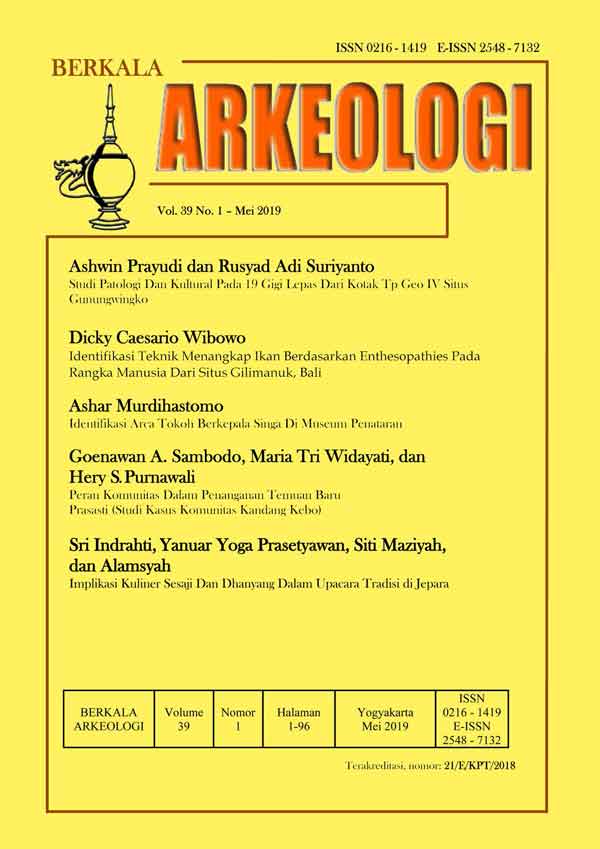PERAN KOMUNITAS DALAM PENANGANAN TEMUAN BARU PRASASTI (STUDI KASUS KOMUNITAS KANDANG KEBO)
Main Article Content
Abstract
The aim of this study is to identify and analyze the efforts of the Kandang Kebo Community in handling new found inscriptions. The method used is descriptive-qualitative, combined with inductive reasoning. Structural analytic, especially Internal Criticism (transliteration, translation and interpretation) is also applied to analyse the new found inscription. Information for this study were collected from the members of Kandang Kebo community, stakeholders, and local community. Data collection were done by observation, literature study, interviews, and documentation. This study found that community which participate in maintaining cultural heritage objects is a provision in the Cultural Heritage Act no. 11 of 2010. Kandang Kebo as a society's community has been trying to apply this Act. The using of social media becomes one of the methods, with its quick and easy way; it makes new artifacts discovery easier to be known by others. Kandang Kebo then proceed this news to the office of BPCB. There are some inscriptions that are successfully saved and read by Kandang Kebo, followed by positive responses from the government.
Article Details

This work is licensed under a Creative Commons Attribution-NonCommercial-ShareAlike 4.0 International License.
References
Acri, A. (2016). “Once More on the ‘Ratu Boko Mantra’; Magic, Realpolitik, and Bauddha- Åšaiva Dynamics in Ancient Nusantaraâ€. -Chapter 13. Esoteric Buddhism in Mediaeval Maritime Asia hlm 323-348, Singapore, ISEAS Publishing.
Anonim. Diunduh dari https://kebudayaan.kemdikbud.go.id/ditsejarah/kongres-nasional-komunitas-sejarah-dan-geliat-ekosistem-budaya-kampung-madu/ diakses 27 Feb 2019 jam 09.30 WIB
Bosch, FDK. (1925). Oudheidkundig Verslag, hlm 18-19. Weltevreden : Albrecht & Co. ’s-Hage, M.Nijhoff.
Crow, G., and Allan, G., (1994). Community Life: An introduction to local social relations. New York : Hemel Hempstead: Harvester Wheatsheaf.
Damais, L.Ch. (1952). I. Etudes d'Épigraphie Indonésienne, III 'Liste des Principales Inscriptions Datees de I'Indonsie. BEfEO 1952 Tome 46 N°1, hlm 1-105. Hanoi : Paris Imprimerie Nationale.
Darmosoetopo, R. (2008) Penyepadanan tahun Saka ke tahun Masehi pada data tertulis. Makalah tidak diterbitkan.
DITPCBM. (2015). Prasasti-prasasti di Kalimantan Barat. Diunduh dari https://kebudayaan.kemdikbud.go.id/ditpcbm/prasasti-prasasti-di-kalimantan-barat/ 27 Feb 2019 jam. 10.00 WIB
Djubiantoro, T. (2011). Vademekum Benda Cagar Budaya, Cetakan V. Jakarta : Departemen Pendidikan dan Kebudayaan,.
Goris, R. (1928). De Oud-javaansche Inscripties unit het Sri-Wedari Museum to Soerakarta. Oudheidkundig Verslag. 1928, hlm 63-70. Weltevreden : Albrecht & Co. ‘s-Hage, M.Nijhoff.
Griffiths. A. (2014). Written traces of the Buddhist past: Mantras and Dharanis in Indonesian Inscriptions. Bulletin of the School of Oriental and Africans Studies 77 (01). 137--194. https://doi.org/10.1017/s0041977X14000056.
Indrawan, A., dan Ichsan A.S., (2014). https://www.republika.co.id/berita/nasional/umum/14/05/03/n4zzx1-prasasti-majapahit-hilang-masyarakat-minta-investigasi diakses 1 Maret 2019 jam. 14.25 WIB
Kertajaya, H. (2008). Arti komunitas. Jakarta: Gramedia Pustaka
Nastiti, TS. (2009). Kedudukan dan Peranan Perempuan dalam Masyarakat Jawa Kuna (Abad VIII-XV Masehi). Disertasi. Program Studi Arkeologi. Fakultas Ilmu Pengetahuan Budaya. Universitas Indonesia
Navvab, M., Bisegna, F., Gugliermetti, F. (2013)“Experiencing the Tangible Past through Virtual Reconstruction: Cultural Heritage of Buildings and their Environmental Boundariesâ€; Journal Archaeomatica, September 2013, IV (3). 36-41. Roma, Italy : MediaGEO SOC COOP,.
Poerwadarminto, WJS. (1984). Kamus Umum Bahasa Indonesia. Jakarta: PN Balai Pustaka.
Pradana, Y. (2017). Kebijakan Penguasa Dalam Pelestarian Bangunan Keagamaan Pada Masa Pemerintahan Rakai Watukura Dyaḥ Balitung (898-910 M). Amerta Berkala Arkeologi 35 (1), 47-59. Jakarta : Proyek Penelitian Purbakala, Dep P&K.
Sambodo, GA. (2018). Lingga bertulis di kuburan desa. Penelitian Terkini Prasasti Indonesia.72-82. Yogyakarta : FIB, Universitas Gadjah Mada.
Sarwono, SW. (2015). Teori-Teori Psikologi Sosial. Jakarta: Rajawali Press.
Suhardono. (2014). Pengertian Peran. Diunduh dari http://ariftetsuya.blogspot.co.id/2014/04/pengertian-peran.html diakses 1 Maret 2019 jam 14.05 WIB
Sukmadinata, S. (2007). Metode Penelitian Pendidikan. Bandung: PT. Remaja Rosdakarya.
Sundberg, JR. (2003). A Buddhist mantra recovered from the Ratu Baka plateau; A preliminary study of its implications for Sailendra-era Java. Bijdragen tot de taal-, land- en volkenkunde 159 (1), 163-188, Leiden : Brill, https://doi.org/10.1163/22134379-90003755
Sutopo, HB. (2002). Metodologi Penelitian Kualitatif. Surakarta: Sebelas Maret University Press.
Undang-Undang Republik Indonesia Nomor 11 Tahun 2010 Tentang Cagar Budaya.
Vanina Delobelle. 2008. Corporate Community Management. www.vaninadelobelle.com. diakses 1 Maret 2019 jam 14.15 wib
Wenger, E. et al. 2002. Cultivating Communities of Practice. Harvard Business School Press.

